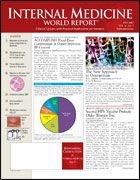Publication
Article
The Uphill Battle Against the Spread of MRSA
Author(s):
By Rebekah McCallister
George
Sakoulas, MD
Staphylococcus aureus
IMWR
S aureus
Overall, 1 in 3 people in the general population are carriers of —often referred to as "staph"—and the vast majority will never develop an infection, George Sakoulas, MD, tells . Staph bacteria are one of the most common causes of infection in the United States, and the line between community-and hospital-acquired methicillin-resistant (MRSA) is becoming increasingly blurred.
Archives of Internal Medicine
S aureus
A recent article in the (2007;167:10261033) has sounded the alert about the increasing spread of MRSA in the community and the risk of transmission in public housing, sports outlets, and public hospitals. These infections, the investigators say, are increasing in addition to, not instead of, methicillin-susceptible among persons without health insurance. This is changing the way physicians should think of MRSA infections, which until recently has been associated with hospitals.
Within hospitals, certain conditions help to "fuel the fire" and increase susceptibility, including tight quarters, increased person-to-person contact, and exposure to different antibiotics. It is ironic that infections are thriving in a place that is intended to treat rather than introduce disease, and that "the longer you're in a hospital, the more likely it is that these things are going to happen to you," says Dr Sakoulas, of the Department of Medicine, Division of Infectious Diseases, New York Medical College, Valhalla.
Preventive measures in the hospitals, including handwashing and judicious use of antibiotics, will not completely eliminate hospital-based MRSA, he says. But the problem goes deeper than this. "If you look at the real world, doctors have to see more patients in less time. And when Medicare and all these third-party payers say we're going to cut reimbursement by 9% or 10%—it seems very innocuous, but what does that really mean? It means doctors, instead of seeing 20 patients in a day, are seeing 30 patients in a day." And that means that preventive measures such as handwashing between patients "are going to be more difficult to adhere to."
Community-Associated MRSA
The barrier between hospital-acquired and community-associated MRSA (CA-MRSA) is getting fuzzier. "Traditionally speaking, hospital-acquired MRSA is the staph that has been around in hospitals for the last 20 or 30 years," he notes.
In contrast, CA-MRSA is a relatively new phenomenon. "In the last 6 or 7 years…a similar gene that is found in hospital MRSA jumped into a few of the staph clones that live in the community and has created an MRSA with properties of community-type organisms," Dr Sakoulas explains.
Compared with hospital-based infections, "The community staph tends to affect younger, healthier people, and typically causes skin infections. And the bacteria tend to be more susceptible to other kinds of antibiotics, so it's really only methicillin that it's resistant to," he says.
It used to be relatively simple to tell the 2 strains apart, but the differences are becoming increasingly nebulous, as carriers of CA-MRSA are entering the hospital for other reasons and are spreading the bacteria.
"To be able to tell these strains apart now, you can't really…say, 'Where did the patient come from? Was he in the hospital, or was he in the community?' You've got to do the genetic tests to see, and you'll find that a fair number of MRSA infections that are developing in hospitals are actually strains that have the same or similar properties as the community strains," Dr Sakoulas says.
And now that these infections are "moving into hospitals, they're under a lot more pressure from antibiotics, and therefore they've become resistant to antibiotics as well. I suspect that within 5 years it'll be very difficult to tell these strains apart."
Choosing the Best Antibiotic
Choosing the right antibiotic for MRSA now requires "a lot of judgment," he says. "The traditional antibiotic we've used is vancomycin [Vancocin]….When I trained and when a lot of more experienced physicians trained, MRSA equaled vancomycin, and that was the end of that."
Today there are more options: linezolid (Zyvox) was introduced in 2000, followed in 2003 by daptomycin (Cubicin), and in 2005 by tigecycline (Tygacil).
"Depending on the site of infection, you can pick and choose from these. For somebody who is not as sick…you can use some of the older antibiotics."
But the staph bacteria evolve very quickly. "So even though on paper vancomycin should work against MRSA, staph has evolved to be able to counteract vancomycin therapy and, as a result, vancomycin doesn't work, even though the laboratory tells you that the organism is susceptible," he says.
But even the newer antibiotics won't work against MRSA forever, he warns. "Keep in mind that there is a lot of crosstalk between these antibiotics, and staph that becomes resistant to one of them may become difficult to treat with any other antibiotic, not just that one."
The need for new treatment increases as the infections are spreading. And "unless we keep moving the antibiotic development pipeline, we're going to run out of antibiotics fairly quickly," he says.
Because more than 60% of staph infections are caused by MRSA in the hospital and in the community, when a patient presents with serious pneumonia or a possible staph infection, you should consider it to be MRSA until proven otherwise, Dr Sakoulas stresses.
"Once you get the culture back, and it's not MRSA, you can change antibiotics. But if you have someone you're treating, particularly with a skin infection or…where you think staph is the origin, you've got to think MRSA, and then de-escalate antibiotics if the organism is not MRSA," he says.






